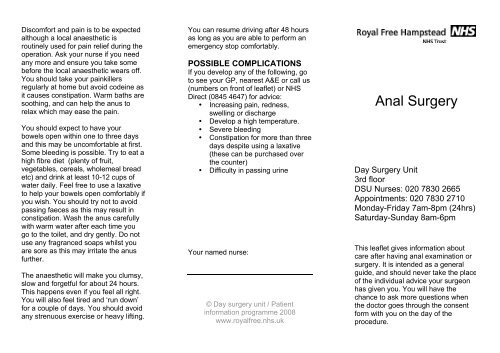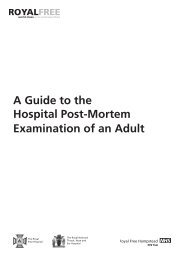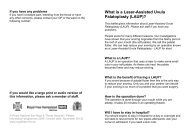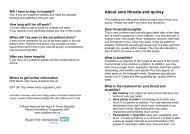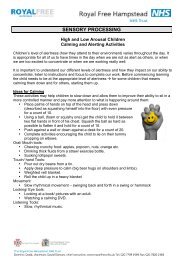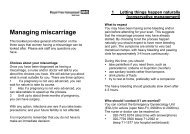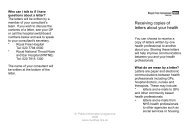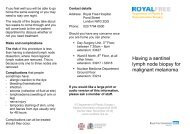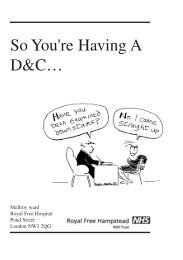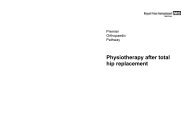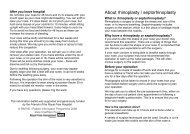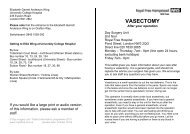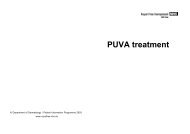Anal Surgery - Royal Free Hampstead NHS Trust
Anal Surgery - Royal Free Hampstead NHS Trust
Anal Surgery - Royal Free Hampstead NHS Trust
You also want an ePaper? Increase the reach of your titles
YUMPU automatically turns print PDFs into web optimized ePapers that Google loves.
Discomfort and pain is to be expected<br />
although a local anaesthetic is<br />
routinely used for pain relief during the<br />
operation. Ask your nurse if you need<br />
any more and ensure you take some<br />
before the local anaesthetic wears off.<br />
You should take your painkillers<br />
regularly at home but avoid codeine as<br />
it causes constipation. Warm baths are<br />
soothing, and can help the anus to<br />
relax which may ease the pain.<br />
You should expect to have your<br />
bowels open within one to three days<br />
and this may be uncomfortable at first.<br />
Some bleeding is possible. Try to eat a<br />
high fibre diet (plenty of fruit,<br />
vegetables, cereals, wholemeal bread<br />
etc) and drink at least 10-12 cups of<br />
water daily. Feel free to use a laxative<br />
to help your bowels open comfortably if<br />
you wish. You should try not to avoid<br />
passing faeces as this may result in<br />
constipation. Wash the anus carefully<br />
with warm water after each time you<br />
go to the toilet, and dry gently. Do not<br />
use any fragranced soaps whilst you<br />
are sore as this may irritate the anus<br />
further.<br />
The anaesthetic will make you clumsy,<br />
slow and forgetful for about 24 hours.<br />
This happens even if you feel all right.<br />
You will also feel tired and ‘run down’<br />
for a couple of days. You should avoid<br />
any strenuous exercise or heavy lifting.<br />
You can resume driving after 48 hours<br />
as long as you are able to perform an<br />
emergency stop comfortably.<br />
POSSIBLE COMPLICATIONS<br />
If you develop any of the following, go<br />
to see your GP, nearest A&E or call us<br />
(numbers on front of leaflet) or <strong>NHS</strong><br />
Direct (0845 4647) for advice:<br />
• Increasing pain, redness,<br />
swelling or discharge<br />
• Develop a high temperature.<br />
• Severe bleeding<br />
• Constipation for more than three<br />
days despite using a laxative<br />
(these can be purchased over<br />
the counter)<br />
• Difficulty in passing urine<br />
Your named nurse:<br />
© Day surgery unit / Patient<br />
information programme 2008<br />
www.royalfree.nhs.uk<br />
<strong>Anal</strong> <strong>Surgery</strong><br />
Day <strong>Surgery</strong> Unit<br />
3rd floor<br />
DSU Nurses: 020 7830 2665<br />
Appointments: 020 7830 2710<br />
Monday-Friday 7am-8pm (24hrs)<br />
Saturday-Sunday 8am-6pm<br />
This leaflet gives information about<br />
care after having anal examination or<br />
surgery. It is intended as a general<br />
guide, and should never take the place<br />
of the individual advice your surgeon<br />
has given you. You will have the<br />
chance to ask more questions when<br />
the doctor goes through the consent<br />
form with you on the day of the<br />
procedure.
PROCEDURES<br />
You may have one or more of the<br />
following common procedures – you<br />
should discuss them with your doctor:<br />
Enema First, you may be given an<br />
enema to empty the rectum before<br />
surgery.<br />
<strong>Anal</strong> examination (EUA): Next, the<br />
doctor examines the anal region using<br />
a special instrument to decide what (if<br />
any) operation is best for you.<br />
Excision (cutting out) of<br />
polyps/warts/skin tags: These will<br />
be examined and removed.<br />
Dissolvable stitches may be inserted.<br />
<strong>Anal</strong> fistula + fistulotomy<br />
An anal fistula is an abnormal<br />
connection between the back passage<br />
(anal canal) and the opening to the<br />
outer skin surrounding the anus. On<br />
the surface of the skin around the<br />
anus, one or more of the fistula ends<br />
may be seen as holes, which tunnel<br />
down into the back passage.<br />
An anal fistula is usually the result of a<br />
previous abscess, which does not heal<br />
properly. An anal fistula is rarely a<br />
serious condition, but it usually<br />
requires surgery which involves<br />
opening and excision of this tunnel. It<br />
maybe left open to heal and may<br />
require regular dressings by your GP<br />
practice nurse. The healing process<br />
normally takes about 2-6 weeks.<br />
More complex fistulas may be<br />
operated on in several stages, and<br />
sometimes a rubber sling (a ‘seton’) is<br />
left in the track to help drainage of any<br />
infected material. Your surgeon will<br />
discuss any other options with you.<br />
It is rare for a fistula to heal without<br />
surgery<br />
<strong>Anal</strong> fissure + sphincterotomy<br />
An anal fissure is a small tear of your<br />
skin just inside the opening of your<br />
anus. It is common in people of all<br />
ages, but is most common in<br />
teenagers and young adults.<br />
They can be very painful, especially<br />
when opening your bowels (passing<br />
faeces). They can be very upsetting<br />
but are very rarely serious. The fissure<br />
may bleed a little and stain the toilet<br />
paper with bright red blood after<br />
opening your bowels.<br />
An anal fissure will usually heal on its<br />
own, but this often takes several<br />
weeks. The fissure may not heal and<br />
may become chronic. This is because<br />
the blood supply may be reduced to<br />
the skin of your anus due to the<br />
muscles tightening in response to the<br />
pain, so preventing healing.<br />
Sometimes an ointment is prescribed<br />
(steroid/local anaesthetic/glyceryl<br />
trinitrate (GTN)) for treatment.<br />
Sometimes the muscle is stretched<br />
under general anaesthetic.<br />
Some people require a minor surgical<br />
operation to cure a chronic anal<br />
fissure. The most commonly used<br />
operation to treat anal fissures is an<br />
internal sphincterotomy (cutting the<br />
internal anal muscle). This procedure<br />
is carried out in hospital under general<br />
anaesthetic. <strong>Surgery</strong> is very effective,<br />
but carries a small risk of some degree<br />
of incontinence (of faeces or wind),<br />
although this may improve with time.<br />
The healing process normally takes<br />
about 2-4 weeks.<br />
AFTER THE OPERATION<br />
You will be able to eat and drink<br />
straight away once on the ward. You<br />
will normally have a dressing in place<br />
around the entrance of the anus. This<br />
is to control any bleeding in the area.<br />
The dressing may sometimes be inside<br />
the anus, which may feel strange and<br />
possibly rather uncomfortable. It may<br />
also feel that you want to open your<br />
bowels (although you are not likely to<br />
do so). You may need to wear a pad to<br />
prevent soiling of your clothes as some<br />
bleeding is to be expected.


